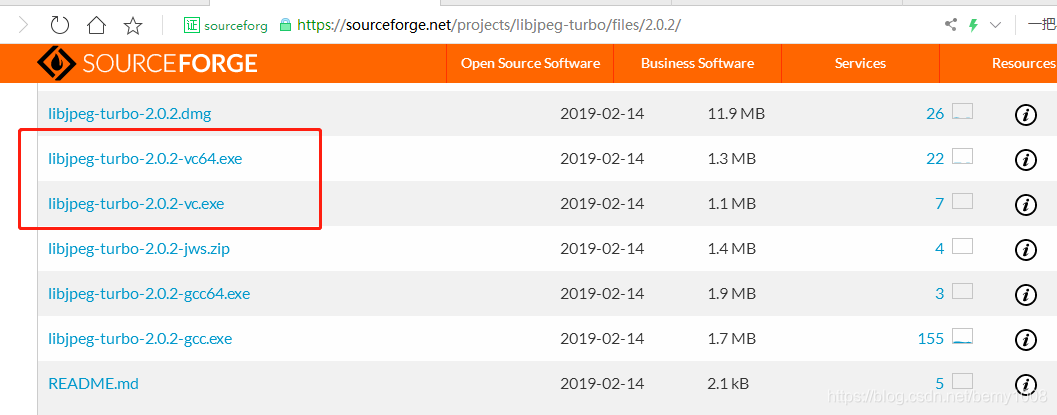平时都用OpenCV的imwrite存图,保存为bmp格式的图片,速度快但占用空间大;存为jpg格式,占用空间小但存图时间长。
了解到libjpeg这个开源库存图,实验了一下,老版的libjpeg与OpenCV相比,没有优势。新版的libjpeg-turbo就不一样了,存图效率很高。
(1)从官网下载最新版本的libjpeg-turbo
https://libjpeg-turbo.org/

(2)安装.exe文件,解压压缩包

(3)应用
参考doc文件夹中的example.txt,了解使用步骤
注意:
要求的图片指针数据为 RGB!
要求的图片指针数据为 RGB!
要求的图片指针数据为 RGB!
参数解析:
char filename 要保存的图像文件名
int quality jpg图像的压缩率(0-100)
unsigned char image_buffer 图像指针(RGB排序)
int image_width 图像宽
int image_height 图像高
void write_JPEG_file(char *filename, int quality, unsigned char* image_buffer, int image_width, int image_height)
{
/* This struct contains the JPEG compression parameters and pointers to
* working space (which is allocated as needed by the JPEG library).
* It is possible to have several such structures, representing multiple
* compression/decompression processes, in existence at once. We refer
* to any one struct (and its associated working data) as a "JPEG object".
*/
struct jpeg_compress_struct cinfo;
/* This struct represents a JPEG error handler. It is declared separately
* because applications often want to supply a specialized error handler
* (see the second half of this file for an example). But here we just
* take the easy way out and use the standard error handler, which will
* print a message on stderr and call exit() if compression fails.
* Note that this struct must live as long as the main JPEG parameter
* struct, to avoid dangling-pointer problems.
*/
struct jpeg_error_mgr jerr;
/* More stuff */
FILE *outfile; /* target file */
JSAMPROW row_pointer[1]; /* pointer to JSAMPLE row[s] */
int row_stride; /* physical row width in image buffer */
/* Step 1: allocate and initialize JPEG compression object */
/* We have to set up the error handler first, in case the initialization
* step fails. (Unlikely, but it could happen if you are out of memory.)
* This routine fills in the contents of struct jerr, and returns jerr's
* address which we place into the link field in cinfo.
*/
cinfo.err = jpeg_std_error(&jerr);
/* Now we can initialize the JPEG compression object. */
jpeg_create_compress(&cinfo);
/* Step 2: specify data destination (eg, a file) */
/* Note: steps 2 and 3 can be done in either order. */
/* Here we use the library-supplied code to send compressed data to a
* stdio stream. You can also write your own code to do something else.
* VERY IMPORTANT: use "b" option to fopen() if you are on a machine that
* requires it in order to write binary files.
*/
if ((outfile = fopen(filename, "wb")) == NULL) {
fprintf(stderr, "can't open %s\n", filename);
exit(1);
}
jpeg_stdio_dest(&cinfo, outfile);
/* Step 3: set parameters for compression */
/* First we supply a description of the input image.
* Four fields of the cinfo struct must be filled in:
*/
cinfo.image_width = image_width; /* image width and height, in pixels */
cinfo.image_height = image_height;
cinfo.input_components = 3; /* # of color components per pixel */
cinfo.in_color_space = JCS_RGB; /* colorspace of input image */
/* Now use the library's routine to set default compression parameters.
* (You must set at least cinfo.in_color_space before calling this,
* since the defaults depend on the source color space.)
*/
jpeg_set_defaults(&cinfo);
/* Now you can set any non-default parameters you wish to.
* Here we just illustrate the use of quality (quantization table) scaling:
*/
jpeg_set_quality(&cinfo, quality, TRUE /* limit to baseline-JPEG values */);
/* Step 4: Start compressor */
/* TRUE ensures that we will write a complete interchange-JPEG file.
* Pass TRUE unless you are very sure of what you're doing.
*/
jpeg_start_compress(&cinfo, TRUE);
/* Step 5: while (scan lines remain to be written) */
/* jpeg_write_scanlines(...); */
/* Here we use the library's state variable cinfo.next_scanline as the
* loop counter, so that we don't have to keep track ourselves.
* To keep things simple, we pass one scanline per call; you can pass
* more if you wish, though.
*/
row_stride = image_width * 3; /* JSAMPLEs per row in image_buffer */
while (cinfo.next_scanline < cinfo.image_height) {
/* jpeg_write_scanlines expects an array of pointers to scanlines.
* Here the array is only one element long, but you could pass
* more than one scanline at a time if that's more convenient.
*/
row_pointer[0] = &image_buffer[cinfo.next_scanline * row_stride];
(void)jpeg_write_scanlines(&cinfo, row_pointer, 1);
}
/* Step 6: Finish compression */
jpeg_finish_compress(&cinfo);
/* After finish_compress, we can close the output file. */
fclose(outfile);
/* Step 7: release JPEG compression object */
/* This is an important step since it will release a good deal of memory. */
jpeg_destroy_compress(&cinfo);
/* And we're done! */
}
最重要的一点:动态调用的方式用问题,但 静态调用 放心大胆的使用!
最重要的一点:动态调用的方式用问题,但 静态调用 放心大胆的使用!
最重要的一点:动态调用的方式用问题,但 静态调用 放心大胆的使用!





 平时用OpenCV存图,bmp格式速度快但占空间大,jpg格式反之。新版libjpeg-turbo存图效率高,可从官网下载,安装.exe文件并解压压缩包。应用时参考doc文件夹中的example.txt,注意图片指针数据需为RGB,静态调用更可靠。
平时用OpenCV存图,bmp格式速度快但占空间大,jpg格式反之。新版libjpeg-turbo存图效率高,可从官网下载,安装.exe文件并解压压缩包。应用时参考doc文件夹中的example.txt,注意图片指针数据需为RGB,静态调用更可靠。

















 1万+
1万+

 被折叠的 条评论
为什么被折叠?
被折叠的 条评论
为什么被折叠?










